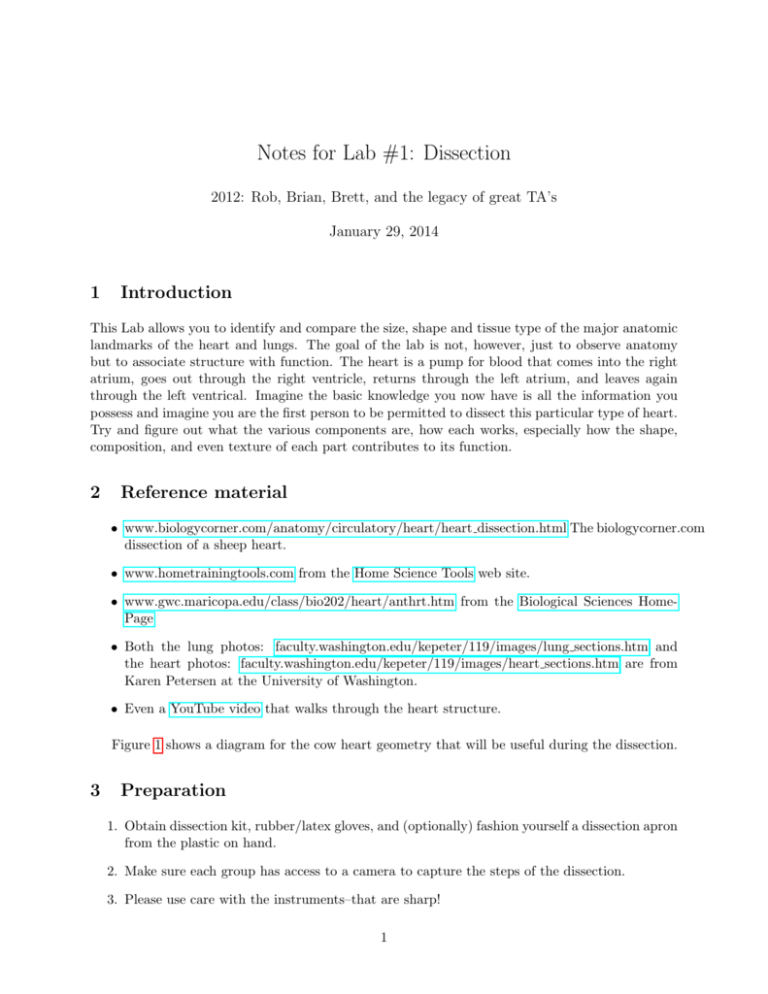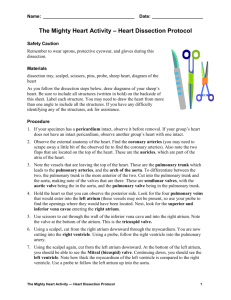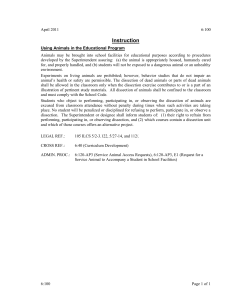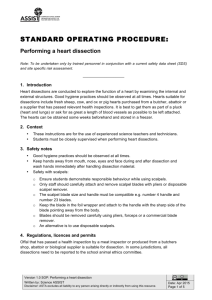Notes for Lab #1: Dissection
advertisement

Notes for Lab #1: Dissection 2012: Rob, Brian, Brett, and the legacy of great TA’s January 29, 2014 1 Introduction This Lab allows you to identify and compare the size, shape and tissue type of the major anatomic landmarks of the heart and lungs. The goal of the lab is not, however, just to observe anatomy but to associate structure with function. The heart is a pump for blood that comes into the right atrium, goes out through the right ventricle, returns through the left atrium, and leaves again through the left ventrical. Imagine the basic knowledge you now have is all the information you possess and imagine you are the first person to be permitted to dissect this particular type of heart. Try and figure out what the various components are, how each works, especially how the shape, composition, and even texture of each part contributes to its function. 2 Reference material • www.biologycorner.com/anatomy/circulatory/heart/heart dissection.html The biologycorner.com dissection of a sheep heart. • www.hometrainingtools.com from the Home Science Tools web site. • www.gwc.maricopa.edu/class/bio202/heart/anthrt.htm from the Biological Sciences HomePage • Both the lung photos: faculty.washington.edu/kepeter/119/images/lung sections.htm and the heart photos: faculty.washington.edu/kepeter/119/images/heart sections.htm are from Karen Petersen at the University of Washington. • Even a YouTube video that walks through the heart structure. Figure 1 shows a diagram for the cow heart geometry that will be useful during the dissection. 3 Preparation 1. Obtain dissection kit, rubber/latex gloves, and (optionally) fashion yourself a dissection apron from the plastic on hand. 2. Make sure each group has access to a camera to capture the steps of the dissection. 3. Please use care with the instruments–that are sharp! 1 Figure 1: Diagram of cow heart anatomy. 4. Use gloves to keep hands clean—animal blood and tissues are not generally harmful but can be slightly irritating to the skin. 4 Dissection Steps 4.1 Entire preparation 1. If necessary, wash your preparation clear of excess blood and spread it out on your bench space. 2. Unpack all the dissection tools from the case and lay them out in some organized fashion; put the case and other materials out of harm’s way. 3. Lay out the heart and lung preparation on the plastic material and take some time to look at the large scale anatomy of what you have. Make sure you can tell heart from lungs, left from right. It will get progressively harder to keep track as you take the preparation apart so perhaps even mark the left and right lungs at this stage. 4. Carefully separate the heart from the rest of the tissue and dissect it clear, leaving at least a few centimeters of the major vessels attached. This is harder than it sounds so be especially careful to keep all chambers of the heart and as much remnant vessls as possible attached. Typical victims of this process are the pulmonary veins, which enter the posterior wall of the left atrium. 2 4.2 Heart 1. Make use of the steps from resources below to help guide the steps for the dissection with one major deviation. The best starting approach is often to open the atria, each one separately and observe their structure as well as the view of the base of the heart from this superior (top) view. For the right atrium one you have identified and photographed the venae cavae (there should be two) cut along a line between the two openings and gradually extend it. A similar cut across the posterior and/or superior aspects of the left atrium is also a good strategy for this chamber. Then before cutting the ventricles, remove the atria so that the base of the ventricles is completely visible and it is possible to identify (and photography) all the vessels and valves. This whole process and the separate examination of the completely removed atria also facilitates examining the structure of the atria and comparing the left and right side by their structure, color, texture and tactile characteristics. 2. Resources: • http://www.hometrainingtools.com • Here are some links to pages of this dissection as PDF files (from Dr. Derek Boughner at the University of Western Ontario: (a) page 1 (b) page 2 (c) page 3 3. Record all measurements in the table in Section 5 below. 4. Note: When dissecting the ventricles, make the first cut of the right ventricle described above only to within 5 cm. of the base of the heart, i.e., the part of the heart where ventricles and atria join. Cutting too far will slice through the tricuspid and mitral valves but it is better to observe and photograph them first intact from both the top and the bottom. Observe the valves by looking into the incision from the apex of the heart (the tip of the ventricles) toward the base. Only then, continue the cut to that you can open (or unwrap) the tricuspid and mitral valves. 5. Make sure to photograph each step several times so you can include images in the lab report showing all the items in the table. Take your time and make lots of photos so you can choose good ones. 4.3 Lungs 1. Separate the lungs from the preparation, being careful to preserve access to the bronchi. 2. Try and inflate the lungs via the bronchi using the rubber tubing connected to the compressed air lines in the lab. 3. Slice open the lungs as in the web site and try to expose bronchi and at least first generation airways (photo). 3 5 Dissection Worksheet Fill out as much of the form below as you can. Some boxes are not relevant (e.g., wall thickness of chordae tendinae) and the choice of size parameters will depend on the structure, but provide reasonable estimates for all the values that you can. In the comments section, describe briefly the notable characteristics of the structure that you observe. Cardiac Structure Dimensions /Diameter(mm) Wall Thickness(mm) Comments Dimensions /Diameter(mm) Wall Thickness(mm) Comments Whole Heart Superior Vena Cava Inferior Vena Cava Right Atrium Right Ventricle Left Atrium Left Ventricle Mitral Valve Aorta Left Main Coronary Right Main Coronary Aortic Valve Aortic Arch Branch vessels Pulmonary Artery Pulmonic Valve Pulmonary Veins Tricuspic Valve Pulmonary Artery Branch Vessels Chordae Tendinae Pulmonary Structure Trachea Left Main Bronchus Right Main bronchus 2nd Generation Bronchus 4 6 Lab report The lab report should consist of 1. Title and your name, as well as the names of your lab partners. 2. A brief (0.5–1 page) Introduction to what you did and what the purpose of the lab was. What was the question and what were the goals of the lab, as you perceived them? This is a good place to summarize the background knowledge of what you know about the heart and lungs going into the dissection. Generally, an introduction provides all the necessary background for what follows. Also include some indication of which feature of the heart you plan to cover in the Discussion section of the lab report. 3. A concise (1 page) Methods section that describes in general terms the steps you took and then lists any deviations from the prescribed sequence or procedures. 4. A Results section that includes text and photos of the major steps of the dissection. There should be images of all the features listed in the table above, which is not to say a separate photo for each! In the photos, identify the objects, organs, or structures of interest. All photos should be digital and incorporated into the document, i.e., no cutting and pasting of paper photos. Each photo must be numbered and have a caption. Each figure must have associated text describing the reader what is notable in the figure. Also include in this section the table of values you recorded from the preparation. 5. A Discussion section in which you select one major anatomical feature of the heart, e.g., one valve, coronary circulation, one chamber, and discuss how its function is related to its structure. Features you might include in this description are the shape, the composition and mechanical properties of the tissue, the texture of any surfaces involved; for each feature, try and suggest functional significance and how the function is linked to the structure. This should be at least a half (single-spaced) page of text and whatever images or supplementary diagrams you think are relevant. Again, try to describe this as though you were the first to ever make the connection and provide evidence from your observations for everything you claim. As with all discussions, begin with an overview paragraph restating the goals and some high level findings and end with a summary paragraph reiterating your findings and perhaps some indication of implications for additional research. The intended audience for your reports should be your fellow students (not the instructor) so use clear, concise scientific prose a level of definition and detail appropriate for this audience. Avoid colloquial language and stick to the vocabulary and style appropriate for proper scientific prose. Please use full sentences (rather than lists) and proper grammar in the report. See the lab report guidelines on the class web site for additional general suggestions. Reports should be single column and single spaced and include color freely wherever it is useful. Submit the report electronically via the Canvas Assignments page in pdf format, i.e., not MS Word. Word documents rarely come through unscathed so make PDF documents from them first. The lab report is generally due two weeks after the first lab day, and you will have the opportunity to submit a second version based on our comments. Note: Just because you have a second chance on the lab report, if you submit an incomplete or clearly poorly written report, you will only waste your time and ours as the suggestions will be obvious and will not help you get to the level that we expect for future reports. 5




